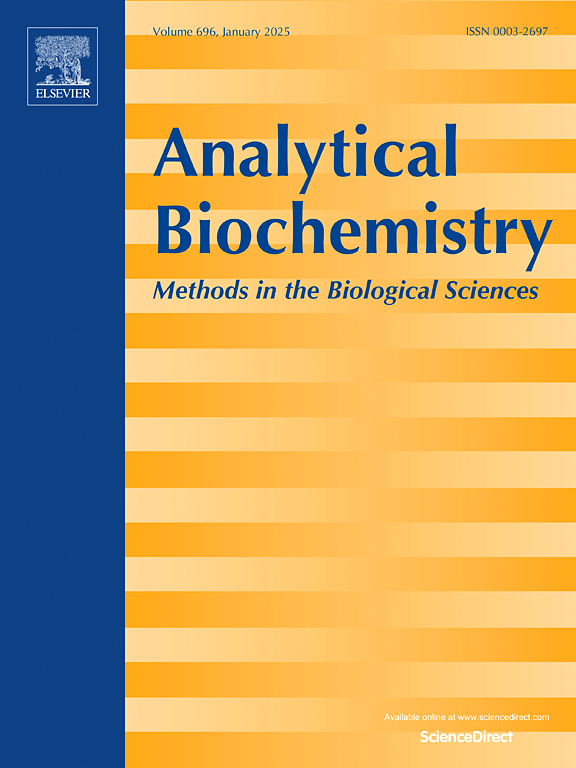Establishment of GDF15 time-resolved fluorescence immunoassay and its clinical application in colorectal cancer
IF 2.6
4区 生物学
Q2 BIOCHEMICAL RESEARCH METHODS
引用次数: 0
Abstract
Objective
This study aimed to develop a highly sensitive time-resolved fluoroimmunoassay for growth differentiation factor 15 (GDF15-TRFIA) and investigate its clinical applicability in colorectal cancer (CRC).
Methods
Using the principle of double-antibody sandwich immunity, the GDF15-TRFIA was established by solid-phase capture antibody and labeled detection antibody with europium as a tracer, the levels of serum GDF15 were quantified in healthy controls (HCs) and patients, and the value of GDF15 in the diagnosis of CRC was analyzed.
Results
The established method has a wide measurement range and good linearity. The HOOK effect was not observed when GDF15 was less than 2000 ng/mL. The intra-analytical coefficients of variation (CVs) were 3.27 %–4.54 %, and the inter-analytical CVs were 5.84 %–10.41 %, and recoveries were 88.15 %–112.36 %. The correlation between GDF15-TRFIA and ELISA was good (ρ = 0.9284). Serum GDF15 levels were significantly higher in CRC patients than in benign colorectal tumor (BCT) patients and HCs (P < 0.0001). ROC analysis showed that simultaneous detection of CEA, CA19-9, and GDF15 significantly improved the diagnostic efficiency of CEA and CA19-9.
Conclusion
A highly sensitive GDF15-TRFIA method for serum GDF15 was successfully established. It can be used for preliminary diagnosis of CRC, and expected to be a good auxiliary tool for the future clinical diagnosis of CRC.
GDF15时间分辨荧光免疫分析法的建立及其在结直肠癌中的临床应用。
目的:建立一种高灵敏度、时间分辨的生长分化因子15 (GDF15-TRFIA)荧光免疫检测方法,并探讨其在结直肠癌(CRC)中的临床适用性。方法:采用双抗体夹心免疫原理,采用固相捕获抗体和以铕为示踪剂的标记检测抗体建立GDF15- trfia,定量测定健康对照(hc)和患者血清GDF15水平,分析GDF15在结直肠癌诊断中的价值。结果:所建立的方法测量范围宽,线性良好。当GDF15浓度低于2000 ng/mL时,未观察到HOOK效应。分析内变异系数(cv)为3.27% ~ 4.54%,分析间变异系数(cv)为5.84% ~ 10.41%,加样回收率为88.15% ~ 112.36%。GDF15-TRFIA与ELISA的相关性较好(ρ=0.9284)。结直肠癌患者血清GDF15水平明显高于良性结直肠肿瘤(BCT)患者和hcc患者(p)。结论:成功建立了一种高灵敏度的GDF15- trfia检测血清GDF15的方法。可用于结直肠癌的初步诊断,并有望成为今后临床诊断结直肠癌的良好辅助工具。
本文章由计算机程序翻译,如有差异,请以英文原文为准。
求助全文
约1分钟内获得全文
求助全文
来源期刊

Analytical biochemistry
生物-分析化学
CiteScore
5.70
自引率
0.00%
发文量
283
审稿时长
44 days
期刊介绍:
The journal''s title Analytical Biochemistry: Methods in the Biological Sciences declares its broad scope: methods for the basic biological sciences that include biochemistry, molecular genetics, cell biology, proteomics, immunology, bioinformatics and wherever the frontiers of research take the field.
The emphasis is on methods from the strictly analytical to the more preparative that would include novel approaches to protein purification as well as improvements in cell and organ culture. The actual techniques are equally inclusive ranging from aptamers to zymology.
The journal has been particularly active in:
-Analytical techniques for biological molecules-
Aptamer selection and utilization-
Biosensors-
Chromatography-
Cloning, sequencing and mutagenesis-
Electrochemical methods-
Electrophoresis-
Enzyme characterization methods-
Immunological approaches-
Mass spectrometry of proteins and nucleic acids-
Metabolomics-
Nano level techniques-
Optical spectroscopy in all its forms.
The journal is reluctant to include most drug and strictly clinical studies as there are more suitable publication platforms for these types of papers.
 求助内容:
求助内容: 应助结果提醒方式:
应助结果提醒方式:


